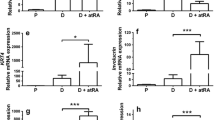Abstract
ALTHOUGH pharmacological doses of retinoic acid (RA) have a wide variety of actions in vivo1, experimental difficulties have prevented a definitive assignment of its physiological functions. We recently made a dominant-negative retinoic acid receptor (RAR>) by a single amino-acid substitution2 which creates a dominant-negative thyroid hormone receptor3. The mutated RAR efficiently inhibited the endogenous activities of RARs (a, β, y)2. Thus, targeted expression of the mutated receptor should reveal RA functions during organogenesis by blocking RA signalling in the tissues concerned. To address this possibility, we expressed the dominant-negative RAR in the epidermis, a potential target organ of RA4. We report here that the resultant transgenic mice exhibited dramatic suppression of epidermal maturation, demonstrating the requirement of RA in normal skin development.
Similar content being viewed by others
References
Armstrong, R. B., Ashenfelter, K. O., Eckhoff, C., Levin, A. A. & Shapiro, S. S. in The Retinoids: Biology, Chemistry, and Medicine 2nd edn (eds Sporn, M. B., Roberts, A. B. & Goodman, D. S.) 545–572 (Raven, New York, 1994).
Saitou, M., Narumiya, S. & Kakizuka, A. J. biol. Chem. 269, 19101–19107 (1994).
Parrilla, R., Mixson, A. J., McPherson, J. A., McClaskey, J. H. & Weintraub, B. D. J. clin. Invest. 88, 2123–2130 (1991).
Peck, G. L. & DiGiovanna, J. J. in The Retinoids: Biology, Chemistry, and Medicine 2nd edn (eds Sporn, M. B., Roberts, A. B. & Goodman, D. S.) 631–658 (Raven, New York, 1994).
Li, E., Sucov, H. M., Lee, K.-F., Evans, R. M. & Jaenisch, R. Proc. natn. Acad. Sci. U.S.A. 90, 1590–1594 (1993).
Lohnes, D. et al. Cell 73, 643–658 (1993).
Lufkin, T. et al. Proc. natn. Acad. Sci. U.S.A. 90, 7225–7229 (1993).
Vassar, R., Rosenberg, M., Ross, S., Tyner, A. & Fuchs, E. Proc. natn. Acad. Sci. U.S.A. 86, 1563–1567 (1989).
Byrne, C., Tainsky, M. & Fuchs, E. Development 120, 2369–2383 (1994).
Hanson, J. J. Anat. 81, 174–197 (1947).
Grüneberg, H. J. Hered. 34, 89–92 (1943).
Fuchs, E. & Green, H. Cell 25, 617–625 (1981).
Wolbach, S. B. & Howe, P. R. J. exp. Med. 42, 753–777 (1925).
Dale, B. A., Holbrook, K. A., Kimball, J. R., Hoff, M. & Sun, T.-T. J. Cell Biol. 101, 1257–1269 (1985).
Weiss, R. A., Eichner, R. & Sun, T.-T. J. Cell Biol. 98, 1397–1406 (1984).
Kopan, R. & Fuchs, E. J. Cell Biol. 109, 295–307 (1989).
Fuchs, E. & Green, H. Cell 19, 1033–1042 (1980).
Hardison, R. C. et al. Cell 18, 1285–1297 (1979).
Gordon, J. W. in Guide to Techniques in Mouse Development (eds Wassarman, P. M. & DePamphilis, M. L.) 747–771 (Academic, San Diego, 1993).
Sanes, J. R., Rubenstein, J. L. R. & Nicolas, J.-F. EMBO J. 5, 3133–3142 (1986).
Kakizuka, A. et al. Cell 66, 663–674 (1991).
Kakizuka, A. et al. Genes Dev. 6, 578–590 (1992).
Davidson, P. & Hardy, M. H. J. Anat. 86, 342–356 (1952).
Ivanyi, D. et al. J. Path. 159, 7–12 (1989).
Stoler, A., Kopan, R., Duvic, M. & Fuchs, E. J. Cell Biol. 107, 427–446 (1988).
Stoler, A., Duvic, M. & Fuchs, E. J. invest. Dermatol. 93, 728–738 (1989).
Steinert, P. M. Biochem. J. 149, 39–48 (1975).
Towbin, H., Staehelin, T. & Gordon, J. Proc. natn. Acad. Sci. U.S.A. 76, 4350–4354 (1979).
Ohkubo, H. et al. Proc. natn. Acad. Sci. U.S.A. 87, 5153–5157 (1990).
Author information
Authors and Affiliations
Rights and permissions
About this article
Cite this article
Saitou, M., Sugai, S., Tanaka, T. et al. Inhibition of skin development by targeted expression of a dominant-negative retinoic acid receptor. Nature 374, 159–162 (1995). https://doi.org/10.1038/374159a0
Received:
Accepted:
Issue Date:
DOI: https://doi.org/10.1038/374159a0
- Springer Nature Limited
This article is cited by
-
Human Induced Pluripotent Stem Cell–Derived Ectodermal Precursor Cells Contribute to Hair Follicle Morphogenesis In Vivo
Journal of Investigative Dermatology (2013)
-
Differentiation of Human Keratinocytes Requires the Vitamin D Receptor and Its Coactivators
Journal of Investigative Dermatology (2007)
-
Dominant negative retinoic acid receptor initiates tumor formation in mice
Molecular Cancer (2006)
-
Upregulation of P2Y2 receptors by retinoids in normal human epidermal keratinocytes
Purinergic Signalling (2006)
-
hRDH-E2 gene polymorphisms, variable transcriptional start sites, and psoriasis
Mammalian Genome (2004)





